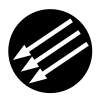Iron Front


The Iron Front (German: Eiserne Front) was an anti-nazi, anti-monarchist and anti-communist paramilitary organization formed in the Weimar Republic.
History
It was formed on 16 December 1931 by the Social Democratic Party (SPD) with the Allgemeiner Deutscher Gewerkschaftsbund (ADGB), the Reichsbanner and workers' sport clubs[1] originally to counter the right-wing Harzburg Front formed by the National Socialist German Workers Party (NSDAP), the Stahlhelm and the German National People's Party (DNVP). The organization sought to engage the old Reichsbanner, the SPD youth organization and labor and liberal groups as a united front. The SPD rallied to the Iron Front, held mass demonstrations, fought fascists in the streets and armed themselves. This is more than the SPD leaders wanted, but SPD workers grew increasingly revolutionary. In 1933, the organization was banned.
Its logo, the Antifascist Circle (three-lined-arrows, pointing south-west/to the lower-left inside a circle) was designed by Sergei Tschachotin, former assistant to the physiologist Ivan Pavlov in 1931.[2][3][4] Designed so as to be able to easily cover Nazi swastikas, the meaning of the three arrows has been variously interpreted. One meaning is that they stood for the opponents of the Iron Front, the three enemies of social democracy: reactionaries (especially monarchists wanting to restore the Hohenzollern monarchy), Communists, and fascism (the Nazis in particular) as seen in a 1932 election poster for the SPD.[5] The present-day Reichsbanner association says the arrows of the logo stood for the SPD, the trade unions, and the Reichsbanner Schwarz-Rot-Gold as well as for the political, economic and physical strength of the working class.[6]
About its formation, Karl Höltermann, chairman of the Reichsbanner, commented: "The year 1932 will be our year, the year of victory of the republic over its opponents. Not one day nor one hour more do we want to remain on the defensive - we attack! Attack on the whole line! We must be part of the general offensive. Today we call - tomorrow we strike!".[7]
The Iron Front downward arrow symbol continues to be used into the 21st century to represent antifascism.[8][9]
See also
| Wikimedia Commons has media related to Eiserne Front. |
Footnotes
- ↑ Andreas Linhardt, Die Technische Nothilfe in der Weimarer Republik Dissertation, Braunschweig University of Technology (2006), p. 667 ISBN 978-3-8334-4889-8. Retrieved August 6, 2011 (in German).
- ↑ Friedrich-Wilhelm Witt, "Die Hamburger Sozialdemokratie in der Weimarer Republik". Unter besonderer Berücksichtigung der Jahre 1929/30 - 1933 ("Hamburg Social Democracy in the Weimar Republic". With special consideration of the years 1929/30 - 1933), Hannover 1971, p. 136
- ↑ Sergei Tschachotin, Dreipfeil gegen Hakenkreuz ("Three Arrows Against the Swastika"), Kopenhagen 1933 (Source: Biography of S. Tschachotin) - Book was reviewed by Dieter Rebentisch in the periodical, Archiv für Sozialgeschichte ("Archives for Social History") #12 (1972), p. 679-???, ISSN 0066-6505
- ↑ Dr. Richard Albrecht, PhD., "Dreipfeil gegen Hakenkreuz" - Symbolkrieg in Deutschland 1932 ("Three Arrows Against the Swastika" - symbol war in Germany 1932". Historical Case-Study in Anti-Nazi-Propaganda Within Germany and Western Europe, 1931-35), pub. January 2005
- ↑ SPD poster for 1932 elections Retrieved August 6, 2011 (in German).
- ↑ "Die Eiserne Front" Archived 7 October 2011 at the Wayback Machine. Bundesverband Reichbanner Schwarz-Rot-Gold, Bund Aktiver Demokraten e. V. Retrieved August 6, 2011 (in German).
- ↑ Werner K. Blessing, "Dok. 9 Aufruf des Bundesvorsitzenden Karl Höltermann, Anfang Januar 1932" Bayerische Landeszentrale für Politische Bildungsarbeit Die Weimarer Republik Band III (2003). Retrieved August 6, 2011 (in German)
- ↑ "California 'anti-fascist' activist charged with assault".
- ↑ "What Do The Antifa Symbols Mean? The Flags Often Feature Three Arrows".